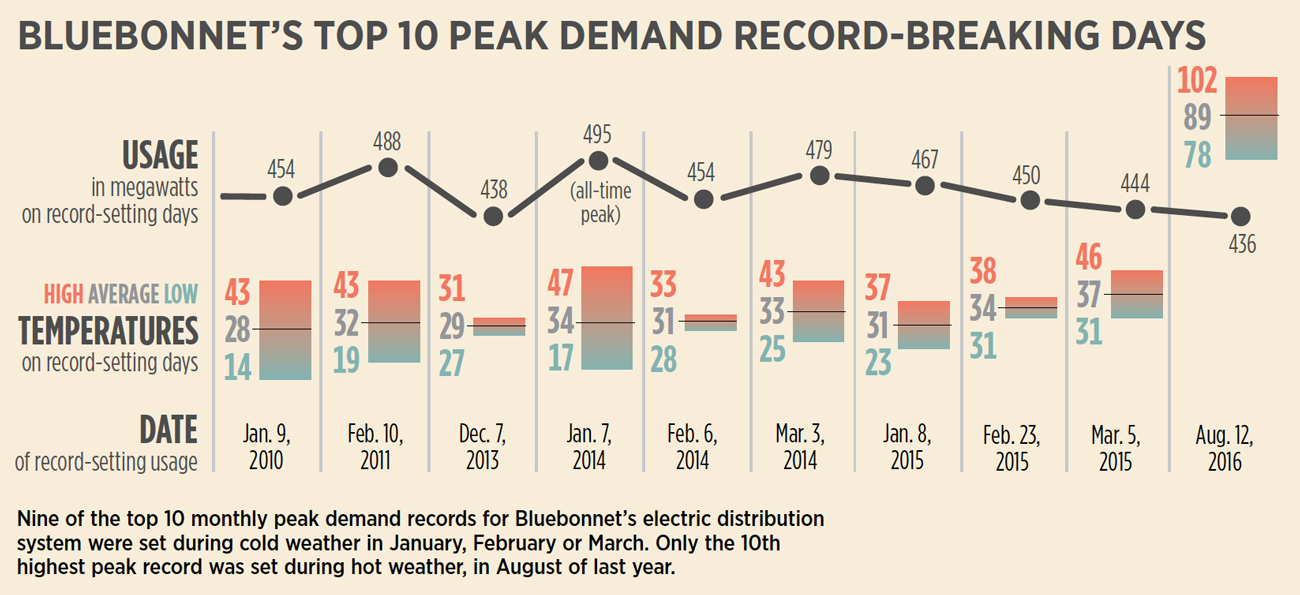
By Will Holford
Winters in Central Texas are typically mild, sunny and beautiful. They’re our reward for enduring long, hot Texas summers. But as all Texans know, winter weather can change from incredibly pleasant to bitterly cold in a matter of hours.
Weather is the driving factor in how much electricity is needed. Hot summer temperatures lead to high demand for energy to cool Texas homes and businesses. The top 10 hourly peak demand records for the Electric Reliability Council of Texas, or ERCOT, which manages the electric grid for most of the state, were all set during August.
But for Bluebonnet, it is the coldest winter mornings that result in the highest demand for electricity. Peak demand for energy occurs at the moment when the most megawatts of electricity are needed to provide enough power to every Bluebonnet member.
Nine of the top 10 monthly peak demand records for Bluebonnet’s electric distribution system were set during January, February or March. Only the 10th highest peak record was set in August.
“Bluebonnet’s peak demand for power is almost always during a winter month,” said Eric Kocian, Chief Engineer and System Operations Officer for the co-op. “Since we see a spike in demand on cold days, particularly in the mornings, it’s almost certainly attributable to homes’ and businesses’ heating systems. Especially on days when temperatures are in the 20s, electric heat systems require a lot of power and really turn the meters.”
Engineer and System Operations Officer for the co-op. “Since we see a spike in demand on cold days, particularly in the mornings, it’s almost certainly attributable to homes’ and businesses’ heating systems. Especially on days when temperatures are in the 20s, electric heat systems require a lot of power and really turn the meters.”
John Osgood, a Bluebonnet member who owns a farm in Uhland and owns a heating and air conditioning business with his brother, Charles, confirmed cold temperatures cause heating systems to use more electricity. Osgood used his own home and farm as examples.
“I’ve got heat pumps at my home and at the farm,” Osgood said. “They are energy efficient and require very little electricity to run the units. But if I go to electric mode (on the heating system), they draw about 70 amps, five times more electricity than when using the heat pump.”
Electric demand at the consumer level is how much electricity a home or business needs to power every electric device in use at that given moment. Demand changes from moment to moment as air conditioners in the summer and heaters in the winter cycle on or off.
At the consumer level, demand is measured in kilowatts, except at large industrial and commercial facilities, where it’s measured in megawatts. One megawatt is enough to power about 200 homes during periods of peak demand.
Electric consumption is the amount of electricity used over a period of time, usually a 29- to 31-day billing period. At the household level, consumption is measured in kilowatt hours. The typical home in Bluebonnet’s service area uses about 1,200 kilowatt hours of electricity per month.
At the utility level, peak demand is how much energy is needed to provide power to every utility customer. Peak demand at the utility level is measured in megawatts, and consumption is measured in megawatt hours.
Confusing? It can be, especially because electricity can’t be seen like water. Here is an analogy that might help: Electric demand is like the amount of water, measured in gallons per minute, flowing through a hose. At peak demand, the water is flowing at full force. At lowest demand, the water is merely trickling out. Electric consumption is equivalent to how many gallons of water you use during a billing period.
ERCOT manages the majority of the state’s electric grid, but every electric utility plays a role in providing safe, reliable power to Texas consumers. From ERCOT to the smallest electric utility in the state, the electric grid must be designed and built to be able to provide enough energy to meet peak demand. As the state’s population increases, so too does demand for energy.
Bluebonnet owns and maintains more than 11,000 miles of electric distribution lines that carry power from 44 electric substations to more than 91,000 meters. Aggregated across its entire system, the co-op uses peak demand data as one way to measure growth on its electric grid. It also looks at the peak demand data at the substations and the power lines, called feeders, which carry power from the substations to the meters. Bluebonnet’s substations provide power from two to as many as five feeders. A feeder can serve several thousand meters along dozens of miles of line.
“The peak demand data at the feeder level shows us how that section of line is performing and if we need to make improvements in order to serve the electric load, especially during periods of peak demand,” Kocian said. “We constantly look at the data from the substations to the last meter at the end of the line to ensure reliability and plan for future growth.”





